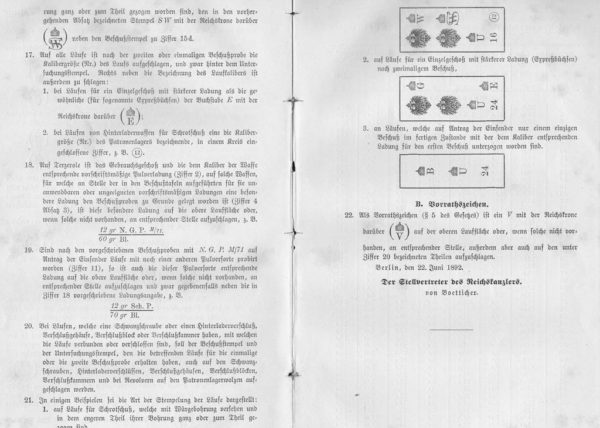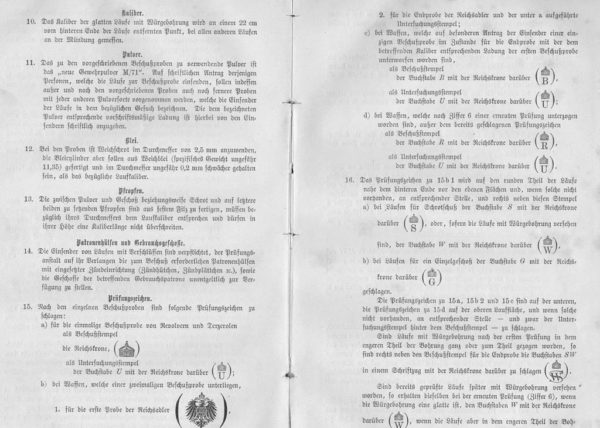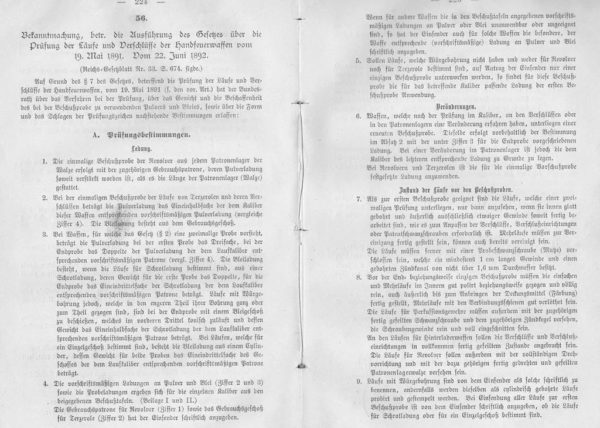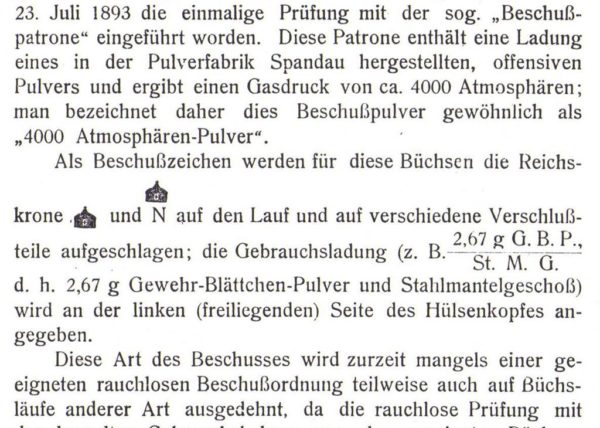Gun Marks
A Proof Mark Primer - 1891-1939
By Steve Meyer, German Gun Collectors Association
Unravelling the history of a German sporting gun or rifle is often a difficult proposition. With the exception of a few larger makers like J.P.Sauer, Merkel and Krieghoff most records are lost and only the guns themselves bear testimony to the history, workmanship and artistry of German gunsmiths.
Fortunately, one source remains to us, and that is the marks on the guns themselves. Beginning with the first German proof law that came in to effect on April 1, 1893, all sporting firearms produced in Germany were required to pass rigorous strength and safety tests at a government regulated proof house. The Proof law was signed May 19, 1891, the proof rules, marks and tables were decreed on June 22, 1892, and became effective on April 1, 1893. Over the years German proof laws, like those of other European countries, were revised to cover changes in gunpowder, materials and design, and changes in proof law and the marks prescribed can be very helpful in tracing date of manufacture, chambering and originality.
I won't attempt to cover the all ins and outs of German proof law here in detail, but there are a few bits useful for dating that frequently come in handy.
Guns and rifles built in Germany and the German principalities before the 1890s typically did not carry proof marks, but the 1891 proof law 'grandfathered' these arms by mandating that they be submitted to the proof house and marked with a crown-over-V, the V standing for Vorrat or 'on hand'. Any German gun or rifle carrying a crown-over-V dates to March 1893 or earlier.
Marks showing crowns over the letters B = Beschuss = proof load fired, U = Untersuchung = inspected/viewed for defects, (proof approved); G = Geschoss = for solid bullet, most often rifled barrels, S = Schrot = proofed for a shot load (smoothbore) and W = Wuergebohrung =(choked bore) span the period from the first German proof law until 1939, but there are other marks usually present that can narrow the date range greatly.
Rifles marked with only an indication of powder charge and bullet type as shown below date to 1912 or before:
2,67 g GBP
St m G
These marks show 2,67 grams of Gewehr Blättchen Pulver (military flake powder) and Stahl-mantel Geschoss (steel jacketed bullet). Other possible types are "K m G" for Kupfer-mantel Geschoss (copper jacketed bullet) and "Bl G" for Blei Geschoss (plain lead bullet).
After 1912 marks were changed to show just bullet type and bullet weight as in:
St m G
12 g
usually accompanied with a crown-over-N on rifle barrels or the word Nitro on shot barrels, specifying smokeless powder. The Suhl proof house marked the word Nitro in straight letters, while the Zella –Mehlis proof house used script.
Shotgun barrels of this era will sometimes be marked with a powder charge over a shot weight, but the style of the marks didn't change markedly over time. All guns were marked with the standard service load they were proofed for. Shotgun barrels will also be marked with the gauge designation in a circle and, unless they are specifically stamped otherwise, will be chambered for 65mm or 2-1/2" shells. As an interesting sidelight, I have seen more than one German double rifle advertised that bore crown-over-W marks on the underside of the barrels. A closer inspection revealed that their rifled barrels had been sleeved into the shotgun barrels or block and they were in no way original, or perhaps even safe. Caveat emptor!
The most frustrating but perhaps the most useful marks of the 1891-1939 era are the various sets of just numbers often present. The two most common sets of numbers applied were bore dimensions and actual proof dates.
Rifles from later in this era are sometimes stamped with a bore (not groove) diameter in millimeters, the most common being 8,8mm for one of the 9,3mm cartridges and 7,7mm for one of the many 8mm cartridges.
Note: Since many guns passed through more than one set of hands (for example a barrel knitter or an actioner), the guns will be marked with someone’s initials. For the most part, these individuals remain anonymous. Also, to keep the parts straight, many times the parts will be marked with the last two or three numbers of the serial/ work order number.
Many earlier rifles will be found with numbers indicating the "gauge" diameter of the bore (not groove). For instance 108/49 would indicate a bore diameter from .350-.359" and hence likely to be a 9,3mm chambering of some kind, while 172/28 (.300-.309") would indicate an 8mm of some kind.
See table below for rifle gauge numbers.
The other set of numeric marks often found on both rifles and guns is the actual date code of proof. The style of these numbers can easily be confused with the gauge markings described above, so be aware that both possibilities exist. Typical date codes will be three or four digits signifying month and year, as in 513 for May of 1913, or 1127 for November of 1927. Sometimes there will be a dot or slash between the month and year, but most often they are just run together. Often the date code is above a line, with another number below the line. The number below the line is that gun's actual entry number in the proof house records for that month and year except for a short time around 1923, such ledger numbers indicate Zella –Mehlis proof. They were not used by the Suhl proof house most of the time.
On rifles for smokeless cartridges, proofed 1893 to about 1923, you may see different proof marks. Instead of the usual BUG marks you find a small crown over N besides a slightly larger crown. These CROWN-crown/N marks indicate proof according to a decree from July 23, 1893. Rifles to be proofed for a service load of GBlP = Gewehrblättchenpulver = standard rifle flake smokeless powder were to be proofed using a special smokeless proof powder that produced 4000 atmospheres pressure in the 8x57I M88 military load. Not mentioned in any of the standard proof mark references.
.
All of the preceding notwithstanding, there is a great deal of variation in proof marks of German guns and entire books have been written on the subject of proofs. One of the best proof mark books isThe Standard Directory of Proof Marks, which is available from our bookshop.
With so little information yet discovered about so many German makers, a working knowledge of proof marks can be your guide to the hidden histories of German sporting arms.
Rifle Gauge Table
A brief table that is pretty helpful for pre-WWI German rifles shows the use of fractional 'gauge' numbers for barrel diameters. This was largest plug gauge diameter that would fit in the bore. The British proof law of 1868 had set up standard gauge sizes from .300" (172.28 gauge) to .450" (51.05 gauge) in .010" increments in the same sense that a shotgun bore is gauged, by the number of round lead balls of that diameter that make a pound. The Germans adopted this somewhat awkward system as well.
Gauge - Inch
51.05 - .450
54.61 - .440
58.50 - .430
62.78 - .420
67.49 - .410
72.68 - .400
78.41 - .390
84.77 - .380
91.83 - .370
99.70 - .360
108.49 - .350 very common on 9,3mms
118.35 - .340 somewhat common on 9,3mms
129.43 - .330
141.95 - .320
156.14 - .310
172.28 - .300 very common on 8mms
Amended downwards by decree May 8,1895. These numbers are in .25 mm increments:
181 - .295
200 - .285
222.5 - .276 found on 7mm rifles
248 - .266
278 - .256 on "6.5mm" .264" bullet rifles
313 - .246 on 6.5x52R = .25-35 Win .257" bullet rifles
353 - .236
401 - .226
459 - .217 on 5.6mm =.22 rifles
611 - .197
712 - .187
These are most frequently seen with a / instead of the decimal point, as in 172/28 or 84/77 Used until 1911 by the Zella-Mehlis proofhouse, 1912 by Suhl.
Rules
Following you will find a few pages from the rules from 1892 in German.




